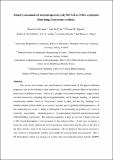| dc.contributor.author | Szczupak, Boguslaw | en |
| dc.contributor.author | Ryder, Alan G. | en |
| dc.contributor.author | Togashi, Denisio M. | en |
| dc.contributor.author | Rochev, Yuri A. | en |
| dc.contributor.author | Gorelov, Alexander | en |
| dc.contributor.author | Glynn, Thomas J. | en |
| dc.date.accessioned | 2010-07-15T13:37:04Z | en |
| dc.date.available | 2010-07-15T13:37:04Z | en |
| dc.date.issued | 2010 | en |
| dc.identifier.citation | B. Szczupak, A.G. Ryder, D.M. Togashi, Y.A. Rotchev, A.S. Klymchenko, A. Gorelov, and T.J. Glynn (2010). Polarity assessment of thermoresponsive poly(NIPAM-co-NtBA) copolymer films using fluorescence methods. Journal of Fluorescence, 20(3), 719-731, ( 2010). | en |
| dc.identifier.uri | http://hdl.handle.net/10379/1201 | en |
| dc.description.abstract | The in-situ, non-contact, and non-destructive measurement of the physicochemical properties such as the polarity of thin, hydrophilic polymer films is desirable in many areas of polymer science. Polarity is a complex factor and encompasses a range of non-covalent interactions including dipolarity/polarizability and hydrogen bonding. A polarity measurement method based on fluorescence would be ideal, but the key challenge is to identify suitable probes which can accurately measure specific polarity related parameters. In this manuscript we assess a variety of fluorophores for measuring the polarity of a series of relatively hydrophilic, thermoresponsive N-isopropylacrylamide/N-tert-butylacrylamide (NIPAM/NtBA) copolymers. The emission properties of both pyrene and 3-Hydroxyflavone (3-HF) based fluorophores were measured in dry polymer films. In the case of pyrene, a relatively weak, linear relationship between polymer composition and the ratio of the first to the third vibronic band of the emission spectrum (I1/I3) is observed, but pyrene emission is very sensitive to temperature and thus not suitable for robust polarity measurements. The 3-HF fluorophores which can undergo an excited-state intramolecular proton transfer (ESIPT) reaction have a dual band fluorescence emission that exhibits strong solvatochromism. Here we used 4¿-diethylamino-3-hydroxyflavone (FE), 5,6-benzo-4¿-diethylamino-3-hydroxyflavone (BFE), and 4´-diethylamino-3-hydroxy-7-methoxyflavone (MFE). The log ratio of the dual band fluorescence emission (log (IN*/IT*)) of 3-HF doped, dry, NIPAM-NtBA copolymer films were found to depend linearly on copolymer composition, with increasing hydrophobicity (greater NtBA fraction) leading to a decrease in the value of log (IN*/IT*). However, the ESIPT process in the polymer matrix was found to be irreversible, non-equilibrated and occurs over a much longer timescale in comparison to the results previously reported for liquid solvents. | en |
| dc.format | application/pdf | en |
| dc.language.iso | en | en |
| dc.publisher | Springer | en |
| dc.rights | Attribution-NonCommercial-NoDerivs 3.0 Ireland | |
| dc.rights.uri | https://creativecommons.org/licenses/by-nc-nd/3.0/ie/ | |
| dc.subject | ESIPT | en |
| dc.subject | 3-Hydroxyflavone | en |
| dc.subject | Pyrene | en |
| dc.subject | Proton-Transfer | en |
| dc.subject | Polarity | en |
| dc.subject | Thermoresponsive | en |
| dc.subject | Polymer | en |
| dc.subject | Fluorescence | en |
| dc.subject | Information technology | en |
| dc.title | Polarity assessment of thermoresponsive poly(NIPAM-co-NtBA) copolymer films using fluorescence methods. | en |
| dc.type | Article | en |
| dc.local.publishedsource | http://dx.doi.org/10.1007/s10895-010-0613-5 | en |
| dc.local.publisherstatement | The original publication is available at www.springerlink.com | en |
| dc.description.peer-reviewed | peer-reviewed | en |
| nui.item.downloads | 600 | |


